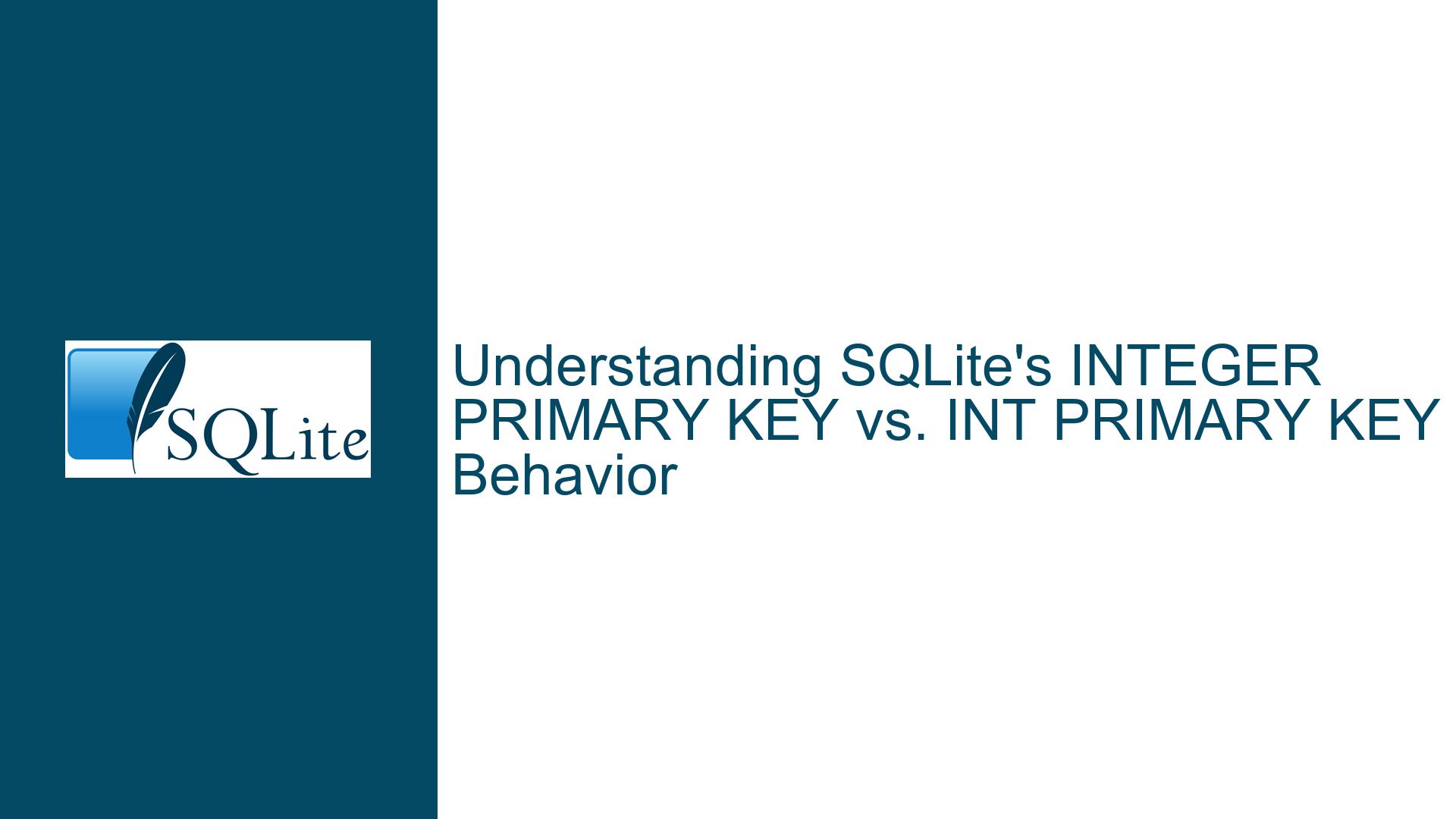SQLite’s INTEGER PRIMARY KEY vs. INT PRIMARY KEY Behavior
The Distinction Between INTEGER PRIMARY KEY and INT PRIMARY KEY in SQLite
SQLite is a lightweight, serverless database engine that is widely used due to its simplicity, portability, and efficiency. One of its unique features is the way it handles primary keys, particularly the distinction between INTEGER PRIMARY KEY and INT PRIMARY KEY. This distinction is not immediately obvious and can lead to confusion, especially for those who are new to SQLite or who are accustomed to other database systems where such distinctions do not exist. This post will delve into the nuances of this behavior, exploring why it exists, its implications, and how to work with it effectively.
The Role of Rowid and Primary Keys in SQLite
In SQLite, every table has a hidden column called rowid that uniquely identifies each row in the table. The rowid is an integer value that is automatically assigned by SQLite when a row is inserted, and it can be used to efficiently access and manipulate rows. However, SQLite also allows you to define a column as an INTEGER PRIMARY KEY, which has a special behavior: it becomes an alias for the rowid. This means that the column not only serves as the primary key for the table but also directly references the internal rowid.
The key point of confusion arises when you define a column as INT PRIMARY KEY instead of INTEGER PRIMARY KEY. While both INT and INTEGER have the same affinity (i.e., they both store integer values), only INTEGER PRIMARY KEY causes the column to become an alias for the rowid. INT PRIMARY KEY, on the other hand, does not have this special behavior. Instead, it behaves like a regular column with integer affinity and a unique index, but it does not alias the rowid.
This distinction is not arbitrary; it is a deliberate design choice that has been part of SQLite since its early days. The decision to make INTEGER PRIMARY KEY an alias for the rowid was made to optimize performance and simplify certain operations, particularly in the context of SQLite’s lightweight architecture. However, this design choice can be surprising to those who expect INT PRIMARY KEY to behave the same way, especially if they are coming from other database systems where such distinctions do not exist.
Why INTEGER PRIMARY KEY is Special in SQLite
The special behavior of INTEGER PRIMARY KEY in SQLite is rooted in the database engine’s internal architecture. When you define a column as INTEGER PRIMARY KEY, SQLite optimizes the storage and retrieval of data by directly linking the column to the rowid. This has several important implications:
Efficient Storage: Since the
INTEGER PRIMARY KEYcolumn is an alias for therowid, SQLite does not need to store the value of this column separately. Instead, it uses therowidas the storage mechanism, which reduces the amount of data that needs to be stored and improves performance.Automatic Increment: When you insert a new row into a table with an
INTEGER PRIMARY KEYcolumn, SQLite automatically assigns a uniquerowidto the new row. If you do not explicitly provide a value for theINTEGER PRIMARY KEYcolumn, SQLite will automatically generate a value that is one greater than the largestrowidcurrently in the table. This behavior is similar to theAUTOINCREMENTfeature in other database systems, but it is more efficient because it directly leverages therowidmechanism.Direct Access: Because the
INTEGER PRIMARY KEYcolumn is an alias for therowid, you can use it to directly access rows in the table. This can be particularly useful for operations that require frequent access to individual rows, such as updates or deletes.Backward Compatibility: The special behavior of
INTEGER PRIMARY KEYhas been part of SQLite since its early days, and changing it now would break backward compatibility with existing applications that rely on this behavior. This is one of the reasons whyINT PRIMARY KEYdoes not have the same behavior, even though it might seem more intuitive for it to do so.
The Implications of Using INT PRIMARY KEY
When you define a column as INT PRIMARY KEY, it does not become an alias for the rowid. Instead, it behaves like a regular column with integer affinity and a unique index. This has several implications:
Separate Storage: Unlike
INTEGER PRIMARY KEY, which uses therowidfor storage,INT PRIMARY KEYrequires SQLite to store the value of the column separately. This increases the amount of data that needs to be stored and can have a minor impact on performance.No Automatic Increment: When you insert a new row into a table with an
INT PRIMARY KEYcolumn, SQLite does not automatically assign a unique value to the column. If you want the column to auto-increment, you need to explicitly define it asAUTOINCREMENT. However, even withAUTOINCREMENT, the behavior is different fromINTEGER PRIMARY KEYbecause it does not directly leverage therowidmechanism.No Direct Access: Because
INT PRIMARY KEYis not an alias for therowid, you cannot use it to directly access rows in the table. Instead, you need to rely on the unique index that is created for the column, which can be less efficient than using therowid.Potential for Confusion: The distinction between
INTEGER PRIMARY KEYandINT PRIMARY KEYcan be confusing, especially for those who are new to SQLite or who are accustomed to other database systems where such distinctions do not exist. This can lead to unexpected behavior if you mistakenly useINT PRIMARY KEYwhen you intended to useINTEGER PRIMARY KEY.
Why the Distinction Exists
The distinction between INTEGER PRIMARY KEY and INT PRIMARY KEY in SQLite is a deliberate design choice that reflects the database engine’s focus on simplicity, efficiency, and backward compatibility. The decision to make INTEGER PRIMARY KEY an alias for the rowid was made early in SQLite’s development, and it has been retained ever since because it provides significant performance benefits and simplifies certain operations.
However, this design choice also introduces a potential source of confusion, particularly for those who are not familiar with SQLite’s internal architecture. The fact that INT PRIMARY KEY does not have the same behavior as INTEGER PRIMARY KEY can be surprising, especially if you are coming from another database system where such distinctions do not exist.
The key takeaway is that INTEGER PRIMARY KEY is a special case in SQLite that is optimized for performance and efficiency, while INT PRIMARY KEY behaves like a regular column with integer affinity and a unique index. Understanding this distinction is crucial for designing efficient and effective database schemas in SQLite.
Best Practices for Using Primary Keys in SQLite
Given the distinction between INTEGER PRIMARY KEY and INT PRIMARY KEY, it is important to follow best practices when designing your database schema in SQLite. Here are some recommendations:
Use INTEGER PRIMARY KEY for Primary Keys: If you want a column to serve as the primary key for a table and you want it to alias the
rowid, you should define it asINTEGER PRIMARY KEY. This will provide the best performance and efficiency, as it directly leverages therowidmechanism.Avoid Using INT PRIMARY KEY: Unless you have a specific reason to use
INT PRIMARY KEY, you should avoid it. UsingINT PRIMARY KEYcan lead to confusion and unexpected behavior, and it does not provide the same performance benefits asINTEGER PRIMARY KEY.Use AUTOINCREMENT with Caution: If you need a column to auto-increment, you can use the
AUTOINCREMENTkeyword withINTEGER PRIMARY KEY. However, you should be aware that this can have a minor impact on performance, as it requires SQLite to maintain a separate table to track the largestrowidvalue. In most cases, you do not need to useAUTOINCREMENT, as SQLite will automatically assign a uniquerowidto each new row.Understand the Implications of rowid: When designing your database schema, you should be aware of the role that
rowidplays in SQLite. Understanding howrowidworks and how it interacts withINTEGER PRIMARY KEYcan help you design more efficient and effective schemas.Read the Documentation: SQLite’s documentation is comprehensive and well-written, and it provides detailed information about the behavior of
INTEGER PRIMARY KEYandrowid. Taking the time to read and understand the documentation can help you avoid common pitfalls and make the most of SQLite’s features.
Conclusion
The distinction between INTEGER PRIMARY KEY and INT PRIMARY KEY in SQLite is a subtle but important one that reflects the database engine’s focus on simplicity, efficiency, and backward compatibility. While this distinction can be surprising, especially for those who are new to SQLite or who are accustomed to other database systems, understanding it is crucial for designing efficient and effective database schemas.
By following best practices and taking the time to understand how rowid and INTEGER PRIMARY KEY work in SQLite, you can avoid common pitfalls and make the most of SQLite’s unique features. Whether you are designing a new database schema or optimizing an existing one, keeping these principles in mind will help you achieve the best possible performance and efficiency.






